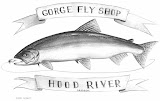Originally brought forth by the “3 Speyketeers” as I call them, Mike McCune/Scott O’Donnell and Ed Ward (Hence the name MOW…McCune-O’Donnell-Ward). The MOW System is nothing short of brilliant!
Available in Light (T-8 format 7.0 ips), Medium (T-11, 8.0 ips),
Heavy (T-14 format @9.0 ips) and Extra Heavy (T-17, 10.0 ips) .
Each MOW Family (Series) has 6 “Family Members”
consisting of the following:
10’
Floating Tip
10’ Sinking Tip
12.5” Sinking Tip
THEN….the
3 MOW’s…..7.5 x 2.5 (7.5 Floating integrated into 2.5 of given make up say
medium as an example in T-11). 2nd MOW is a 5 x 5 (5’ of
Floating integrated into 5’ on sinking).MOW #3 is a 2.5 x 7.5 (2.5 of
Floating Integrated into 7.5 of sinking).
 |
| MOW Tip Kits |
Practical Usages as prescribed below….
10’ Floating Tip : The MOW system
is built for use with Skagit Style Spey Lines . Regardless of Skagit “Type”
(RIO formula’s include Skagit Max Short, Skagit Max & Skagit Max Long) the MOW’s are
formulated to play in the Skagit line theater. The 10’ Floating Tip is a quick
way to “Ala Carte” your Skagit Line into a Full Floating use line.
10’ and 12.5’ Sink Tips: Available throughout
the MOW Range (Light/Medium/Heavy/EX Heavy), these practical length
sink tips play incredibly well with a wide range of Spey and switch rods making
them a wonderful addition to the standard “Traditional” 15’ sink tips
(Intermediate/Type 3, 6 and Type 8). These 2 sink tips will provide the Angler
with sink rates from 7.0 ips (Light T-8) all the way to 10.0 ips (EX Heavy
T-17)that will cover a wide range of use from Alaskan Kings to Tierra Del Fuego
Sea Run Browns as well as the full gamut of Steelhead application.
The 3 True MOW’s
Here is where the absolute Genius of the MOW boys
shines brightest ! Given that any “Cut” sink tip under 9’ is likely going
to basically become a boomerang/tumbler within the cast that will prove to be
ugly at best and ultra frustrating at worst. The “Integration Format” that
McCune/Scotty O and Ed brought to the table from their “Chop Shop” artistry
days providing the stability/cast-ability of a 10’ common denominator in
overall length coupled with the desirable “Baby Tips” making for one of the all
time great innovations.
7.5 x 2.5 (2.5 being the Sinking
Portion): True “Rock Garden/Tail Out Probe Tool”. One could think of a 15’ Type
3 in this instance but the beauty of the MOW idea/format is that the
mere 2.5 sinking portion is simply unrivaled when it comes to sliding around
and thru such haunts. The traditional 15’ sink tip or even the 10’ and
12.5” MOW Sink Tip family members are all prone to “Swing Drag Thru”
often catching/hanging up and killing any real chance at a follow and/or GRAB.
5 x5 (5’ Floating with 5’
Sinking): Again, another Rock Garden probe but long enough to provide
quick drop for given slots particularly in ledge rock environments found in
many Steelhead streams. The 5 x 5 MOW Heavy (T-14 Format) is a great
one for such a task where the angler needs a quick drop into a slot where he’ll
need to engage quickly in order to be in that zone/slot target area. Lots of
Pacific Northwest watersheds feature just such places making the 5 x
5 MOW a handy tool.
2.5 x 7.5 (7.5 being the sinking
portion): My personal favorite in both the standard MOW as well as
IMOW (See Below). This “Baby Tip” if you will has tons of application for a
host of fisheries most certainly including the trout game. Given water depth
and speed considerations often play perfectly into the hands of the 2.5 x
7.5 MOW quite often in the MOW Medium (T-11) format.
Incredibly versatile sliding thru the boulders and swinging “All The way In”
giving both “The Long Followers and The Down Below You” Critters time and
opportunity to run down or run into your swung offering.
iMOW Family
The innovation of the Intermediate style Skagit Heads necessitated
the invention of the iMOW in order to accommodate MOW usage with such
an Intermediate format head (Substituting Integrated Intermediate VS Floating
as found in the original MOW format), this is the obvious use of an iMOW
but certainly not limited to an iFlight/IMAX format line. I personally love the
iMOW’s, as a general MOW use tool as they can, and do have their
place covering a host of angling waters particularly where you know going in,
that the bottom format is relatively clean but needing “Less” of a given sink
tip. iMOW’s come in LIGHT/Medium and Heavy. Kits have 6 family members with the
previously mentioned 10’ floating Tip subbed out for a 10’ Intermediate tip.
iMOW Family:
10’
Intermediate Tip
10’ Sink Tip
12.5” Sinking Tip
The 3 iMOW’s
7.5 x 2.5 (7.5 is intermediate integrated to 2.5 of given sink
tip say iMOW Heavy T-14 as an example)
5 x 5 IMOW
2.5 x 7.5 IMOW
Al in all, the MOW Families have a lot to offer the Spey and Switch Rod enthusiast. I can tell you with absolute confidence that every angler out there has/knows places that are “Made To Order” for MOW use, in particular the 3 True MOW tips. The Spey community owes a lot to the genius of the “3 Speyketeers “ Mike Mc Cune, Scott O’Donnell and Ed Ward.
Find RIO MOW Tips at Gorge Fly Shop
More about Sink Tips in Sink Tips, Polyleaders, VersiLeaders - A Buyers Guide
More about Sink Tips in Sink Tips, Polyleaders, VersiLeaders - A Buyers Guide



















.jpg)





No comments :
Post a Comment